Summary
The Webpage is designed to assist taxpayers, traders and representatives to understand the eFiling function of the enhanced complaints process.
- As part of improved service delivery, the South African Revenue Service (SARS) has introduced a new complaint management process that will facilitate how taxpayer complaints are lodged, tracked and resolved through electronic channels.
- A complaint is defined as a grievance or some form of dissatisfaction experienced by the taxpayer, trader or representative, in relation to a “process” (including queries, returns or any service request) that is not adequately resolved by any of the SARS offices according to the complaints perspective.
- Any mature organisation must provide its clients with a means to communicate any dissatisfaction with their experience when interacting with the organisation in general or more specifically with regard to a service rendered.
- The following complaint categories exist:
- Legal/Policy (e.g. debit cards not accepted for payments)
- Employee behaviour/Competence (e.g. agent X was rude, or agent did not know how to assist me)
- Channel experience/environment/technical issues (e.g. contact centre is very slow to answer, or there is no parking at branch X)
- Quality and speed of service (e.g. incorrect resolution of request, or it took 6 months to process my banking detail change)
- Unresolved service/operational matter (e.g. turnaround time exceeded and my return has not yet been processed)
- Missing or lost documentation (e.g. I have submitted my return, but SARS cannot find it).
- The redesign of eFiling presents SARS with an opportunity to enhance the customer experience by improving platform design, navigation and accessibility to electronic users. Strengthening the access to eFiling ensures protection of taxpayer information and will enhance taxpayer confidence in SARS.
- The eFiling redesign journey aims to enhance the user experience by introducing a user-friendly design and framework. It provides the eFiler with a secure digital transactional platform with SARS and establishes eFiling as the preferred channel. Security processes have been enhanced to curb identified risks while providing enhanced user/profile management and enhancing digital offerings in the self-service environment.
Accessing SARS eFiling
Go to www.sars.gov.za and click ‘LOGIN’ if you are a registered eFiler. If you are not registered for eFiling, click on ‘REGISTER’ and follow the quick steps to register for eFiling.

- For further assistance with eFiling registration, refer to the ‘How to Register for eFiling and Manage Your User Profile’ guide available on the SARS website www.sars.gov.za.
- This function allows you to lodge a complaint regarding any dissatisfaction that you might have experienced.
The eFiling Dashboard screen has been enhanced to assist taxpayers in navigation to the following services:
a) Online Booking – this option will route you to the SARS Online Booking link to schedule an appointment with SARS.
b) Statement of Account
c) My Compliance Status
d) SARS Registered Details
e) Notice of Registration

- By clicking on each tab, you will be navigated to the specific function on eFiling.
- Below are examples of the different eFiling Dashboard screens for Tax Practitioner and Organisation.
Tax Practitioner

Organisation

Access Complaints Management Function
- The Complaints Management function is located under the ‘Services’ menu on your eFiling portfolio.
![]()
- Representatives must ensure that the correct taxpayer is selected from the taxpayer list if they are lodging a complaint on behalf of a taxpayer.
- When the eFiler selects the ‘Services’ menu, the Complaints Management tab will be displayed under the menu items on the left of the page.
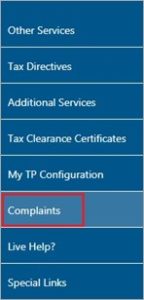
- Click ‘Complaints’ and then ‘New Complaint’ button and an information screen will be displayed that explains the difference between a complaint and a dispute. On the individual profile, click the ‘Next’ button to continue.

- For the Tax Practitioner and Organisations portfolio, the eFiling user has the option to indicate which type of complaint to submit either a ‘General’ or ‘Taxpayer Related’ complaint.
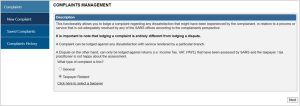
- If ‘General’ is selected, the link to select taxpayer will be not available.
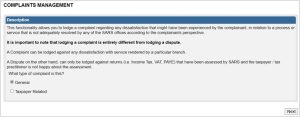
- The ‘Taxpayer Related’ option will be used by tax practitioners that are submitting complaints on behalf of taxpayers.
- Once the ‘Taxpayer Related’ option is selected, a hyperlink ‘Click here to select a taxpayer’ will be displayed to search for taxpayers under the organisation or tax practitioner portfolio. The ‘Taxpayer Search’ screen as indicated below will be displayed.

- In the screen below, a search was done using the tax reference number and results are displayed.
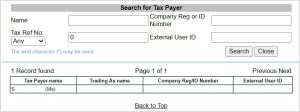
- If you click on the search result, the ‘Taxpayer Name’ will be displayed on the Complaints Management screen. The Complaints Management form will be pre-populated with the details of the selected taxpayer.
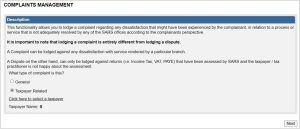
- If you do not select a taxpayer and you click the ‘Next’ button, you will receive the following message to request you to select a taxpayer. Click ‘OK’ to close the message.

- The Complaints Management Form (CM01) will be displayed for completion.
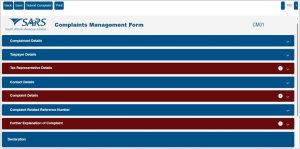
- On the toolbar, the following tabs will be available for selection.

- If you select the ‘Back’ button, the form will be saved and the Complaint Management Work Page will be displayed.
- The ‘Save’ button will allow you to save the form and you can submit at a later stage.
- The ‘Submit Complaint’ button will allow you to submit the complaint to SARS.
- The ‘Print’ button will allow you to print the form.
Completion of Complaints Management Form (CM01)
- The Complaints Management Form (CM01) will be displayed for completion.
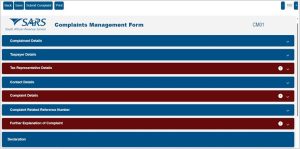
- Container headings displayed in red contain mandatory information to be completed.
- Mandatory fields in the containers are indicated as below:

- Once you have completed a field, it will be displayed in green as per the example below:

- The Form will display the following containers based on selections made previously on the Complaints landing page:
Complainant Details
- This container will consist of details of the complainant and sub-containers may be displayed depending on previous selections.
- Depending on the type of taxpayer, the complainant details container will be pre-selected.
- If “Taxpayer” is selected, the Taxpayer Details container will be displayed. If “Tax Representative” is selected, the “Tax Representative Details” container will be displayed.

- Taxpayer Details: This container consists of the following fields:
- Surname
- First Two Names
- Initials
- ID No
- Passport/Permit No
- Passport Country (e.g. South Africa = ZAR)

- Tax Representative Details: This container consists of the following fields:
- Profile
- Practitioner – if this option is selected, the ‘Professional Membership Body’ and ‘Tax Practitioner Registration No’ fields are mandatory.
- Trustee
- Executor
- Clearing Agent
- Administrator
- Liquidator
- Public Officer
- Partner
- Other
- Profile
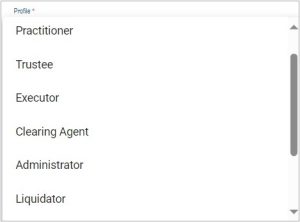
- Surname
- First Two Names
- Initials
- ID No
- Passport/Permit No
- Passport Country (e.g. South Africa = ZAR)
- Professional Membership Body
- ACCA – The Association of Chartered Certified Accountants
- CGISA – Chartered Governance Institute of Southern Africa
- CIBA – Chartered Institute of Business Accountants
- CIMA – Chartered Institute of Management Accountants
- FPI – Financial Planning Institute
- IAC – Institute of Accounting and Commerce
- LPC – Legal Practice Council
- SAICA – South African Institute of Chartered Accountants
- SAIPA – South African Institute of Professional Accountants
- SAIT – South African Institute of Tax Professionals
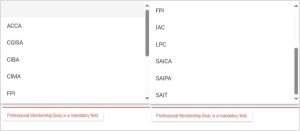
- Tax Practitioner Reg No. – mandatory if profile selected as ‘Practitioner’
- Date of Appointment (CCYYMMDD) – mandatory if Tax Practitioner Reg No. field is completed.
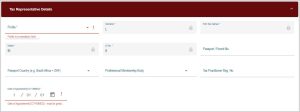
- Contact Details: This container consists of the following fields that must be completed for both the applicant and the tax representative:
- Home Tel No
- Cell No
- Fax No
- Bus Tel No

Complaint Details
- This container will consist of details of the complaint and the following sub-containers may be displayed depending on previous selections:

- Complaint related to: Select either ‘Tax’ or ‘Customs’
- This container consists of the following fields:
- Tax Type – select the relevant tax type from the dropdown box
- Value Added Tax
- Income Tax
- Turnover Tax
- Donations
- Provisional Tax
- Transfer Duty
- Estate Duty
- Payroll Tax (PAYE, UIF and SDL)
- Dividends Tax / STC
- Interest Tax
- Mineral and Petroleum Resource Royalties (MPRR)
- Tax Type – select the relevant tax type from the dropdown box
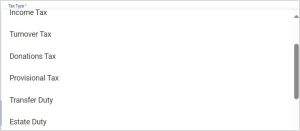
- For Customs the following options will be available to choose from:
- Customs
- Excise Duties and Levies
- For Customs the following options will be available to choose from:
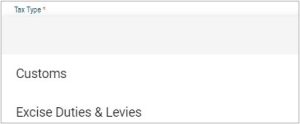
- Complaint Category – depending on the selection, the form will populate the relevant container.
- Unresolved Service / Operational Matter
- Missing or lost documentation
- Legal / Policy
- Employee behaviour / Competence
- Channel Experience / environment / technical issues
- Quality and Speed of Service
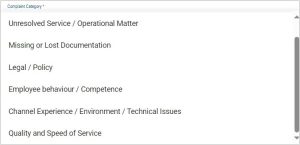
- Complaint Related Reference Number: This container consists of the following fields relating to the reference number(s) of the complaint:
- Taxpayer Ref No.
- Customs Code
- Case Number – this field is mandatory when the complaint category is Unresolved Service/Operational Matter, Missing or lost documentation or Quality and Speed of Service.

- SARS Employee Details: This container will be displayed ONLY if the complaint category selected is Employee behaviour/competence.

- Complete the following fields:
- Surname
- First Two Names
- Employee Division/Area – Tax
- Branch Office
- Call Centre
- Collections
- Outstanding Returns
- Auditor
- Large Business Centre
- VIP Unit
- PSU Unit
- Estates Unit
- Tax Exemption Unit
- High Net Worth Unit
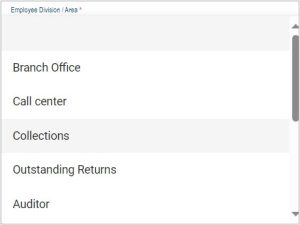
- Employee Division/Area – Customs
- Customs Office
- CBCU Office
- Call Centre
- Auditor
- Employee Division/Area – Customs
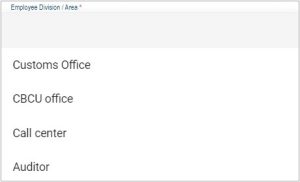
- Branch office – different tax and customs offices will be displayed for selection.
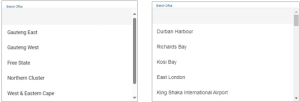
- Approximate date when incident occurred (CCYYMMDD)

- Channel Experience/Environment/Technical Issues: This container will be displayed ONLY if the complaint category selected is Channel Experience or Technical Issues.

- Complete the following fields:
- Channel
- Large Business Centre
- eFiling
- e@syFile™
- IVR
- Contact Centre Operations
- Branch Office or Customs Office – the relevant option will be displayed based on the selection made where the complaint is related to either Tax or Customs.
- Post/Scanning
- Fax and email
- SARS Internet
- SMS
- VIP Office
- PSU Office
- Estates Unit
- Tax Exemption Unit
- EDI
- Channel
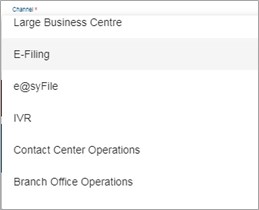
- Process/Service Type
- The process or service type is determined by which option is selected in the complaint details section, either Tax or Customs.

- Branch office – the branch office selection will be determined by the type of complaint selected, either Tax or Customs.
- Quality and Speed of Service: This container will be displayed ONLY if the complaint category selected is Quality and Speed of Service and the following fields must be completed:
- Process/ Service Type
- Branch office
- MRN Number – this will be displayed if the complaint is related to Customs
- The MRN number refers to the Movement Reference number allocated to a customs entry.
- Date (CCYYMMDD)
- Tax Year – this will be displayed if the complaint relates to Tax
- Period – this will be displayed if the complaint is related to Tax.
- Refund Jacket No – this will be displayed if the complaint is related to Customs
- A DA 66 form is used for drawback and manual refund applications. All applications for drawbacks must be made on the prescribed DA 66, commonly referred to as a “Refund Jacket”.
- Date (CCYYMMDD)
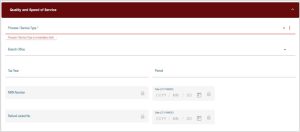
- Unresolved Service/Operational Matter: This container will be displayed ONLY if the complaint category selected is Unresolved Service and Operational Matters and the following fields must be completed:
- Process/Service Type
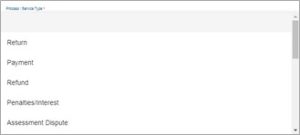
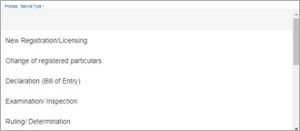
- Branch office
- Branch Office Region
- Gauteng East
- Gauteng West
- Free State
- Northern Cluster
- West & Eastern Cape
- Kwa-Zulu Natal
- Branch Office Region
- Branch office
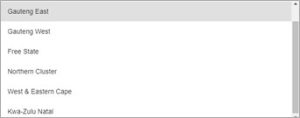
- Please select a Branch Office
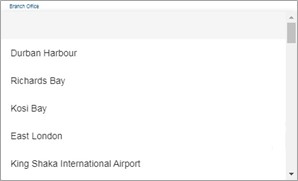
- Approximate number of days outstanding
- This refers to the period that the matter has remained unresolved according to the complainant
- Tax Year – this will be displayed if the complaint relates to Tax
- Period – this will be displayed if the complaint is related to Tax.
- MRN Number – this will be displayed if the complaint is related to Customs
- The MRN number refers to the Movement Reference number allocated to a customs entry.
- Date (CCYYMMDD)
- Refund Jacket No – this will be displayed if the complaint is related to Customs
- A DA 66 form is used for drawback and manual refund applications. All applications for drawbacks must be made on the prescribed DA 66, commonly referred to as a “Refund Jacket”.
- Date (CCYYMMDD)
- Approximate number of days outstanding
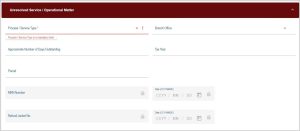
- Missing/Lost Documentation: This container will be displayed ONLY if the complaint category selected is Missing/Lost Documentation and the following fields must be completed:
- Submission channel

- Approximate date (CCYYMMDD)
- Branch office – depending on the selection of the submission channel, the list of branch offices will be generated in a selection box.

- For example, if you select Customs Office as the Submission channel, the following options will be available.
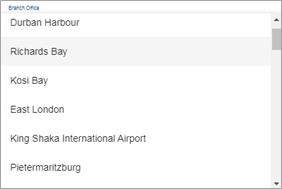
- Legal/Policy: no further container will be populated on form.
Further Explanation of Complaint
- This container will be displayed for all categories.

Declaration
- This container consists of the following declaration by the individual or representative taxpayer:
‘I hereby certify that the information supplied in this form and attached thereto is true and correct in every respect.’

Saved Complaint
- If you have opted to SAVE the complaint form and submit at a later stage, you can click on “Saved Complaints” tab to view the saved complaint forms.
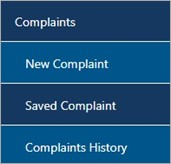
- After you have completed the form, click the ‘Save’ button.

- Click the “OK” button to continue.

- You will be able to view the saved Complaint Management form.

- Click on the “Open” Hyperlink and the Complaint Management Work Page will be displayed.

- You will have the option to delete the saved form by selecting the “Delete Complaint” button. Confirm the deletion by clicking the “OK” button on the prompt message.

- There will be no saved complaints and no records will be displayed.

Submission of Complaints Management Form (CM01)
- Select the “Submit Form” button to submit the CM01 form to SARS.

- A message will be displayed to indicate that the request has been successfully submitted to SARS.
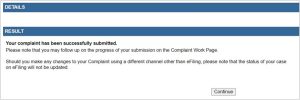
- Upon submission of the form, SARS will provide certain responses if the validations on the form have failed.
Invalid complaint
- This message will be displayed when the complaint or the case number entered is invalid.

- If you click the “Saved Complaints” tab on the menu, the complaints form will be listed and the status will be indicated as “Validation Failure”.

Invalid complaint submission (Repeat Call Escalation (RCE) attached)
- If you have previously submitted a complaint, a new submission will be rejected and the following message will be displayed.

Rejected complaint case
- In the case where the complaint case has been rejected by SARS, the status of the case will be updated on eFiling.

Complaint Management work Page
- The Complaint Management Work Page will be displayed once you have completed a CM01 form and either saved or submitted the form.


- A summary of the complaint will be displayed below the Complainant details containing the following information:
- Form Type
- Submission Date
- Updated by
- Complaint Status
- Status Date
- Case Number.

- On the summary section you will be able to upload supporting documents, query the status of the complaint with SARS or cancel the complaint.

- Upon successful submission of a valid complaint, a complaint case number will be created and indicated on the Complaint Management Work Page.

Query SARS Status
- If you want to enquire the status of your complaint, click the “Query Complaint Status” button on the work page.
![]()
- Examples of the statuses that may be displayed are indicated below.

Upload of Supporting documents
- In the case where the user wants to upload supporting documents or has been requested by SARS to submit supporting documents, these documents can be submitted via eFiling.
- Ensure that the following standards are adhered to when supporting documents are uploaded:
- The file type may be .pdf, .doc, .docx, .xls, .xlsx, .jpg and .gif to enable SARS to view the documents.
- The maximum allowable size per document may not be more than 5MB and a maximum of 20 documents may be uploaded.
- Click on the “Upload Supporting Documents” button. This will open the Supporting Documents section on the Complaint Management Work Page.

- Click on the “Complaint Documents” hyperlink and the “Upload Supporting Documents” screen will be displayed.
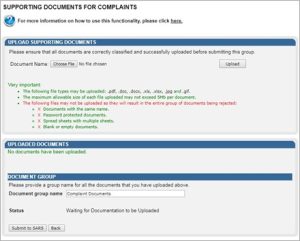
- Click the ‘Choose File’ button to select the files that you want to upload.
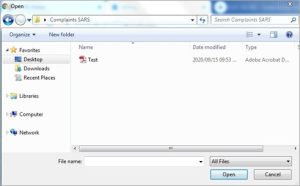
- Click the “Upload” button to load the document onto the page.
- A message will be displayed to indicate if the file has been uploaded successfully. The file will be listed under the Uploaded Documents section of the Upload Supporting Documents page.
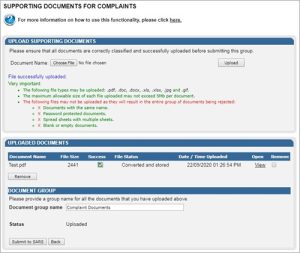
- You will be able to view the document that was uploaded by clicking the “View” hyperlink.

- If you wish to remove the document, click the tick box under the Remove column and then select the “Remove” button.

- Once you have removed the document, the “Uploaded Documents” section will indicate no documents or list the documents you have not selected to be removed.

- To submit the uploaded documents, click the “Submit to SARS” button.
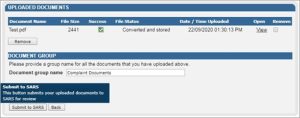
- A message will be displayed to confirm submission of the documents, click “OK” to continue.

- The Complaint Management Work Page will be displayed with the status of the Supporting Documents as “Submitted”.

Cancel Complaint
- In the case where you wish to cancel your complaint, you can select the “Cancel Complaint” button on the work page.
![]()
- You will be prompted to capture a reason or comment why the complaint should be cancelled in the Comment field on the Complaint Cancellation Request page.

- After inserting the reason for cancellation, click the “Continue” button to proceed.
- A warning message will be displayed. Click “Continue” to proceed with the cancellation of the complaint.

- The status on the Complaint Management Work Page will be updated to “Cancellation Requested”.

- If you click the “Complaints History” tab in the menu bar, the cancelled complaint will be listed.

- Once the cancellation request has been processed, the status of the Complaint will be updated to “Cancelled”.
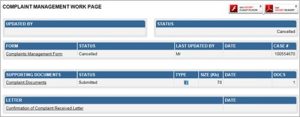
Complaints History
- Once you have submitted the Complaints Management Form, you will be able to view the submitted form in the Complaints History menu.
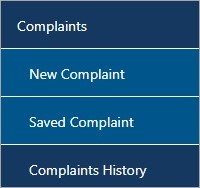
- Click the “Open” Hyperlink on the Complaints History page.

- You will be directed to the Complaint Management Work Page.

- If you have not submitted any complaint forms to SARS, there will be no records to display on the Complaint History page.

View Notifications
- On the Complaint Management Work Page, a section will be displayed that will have all the letters issued regarding the complaint.
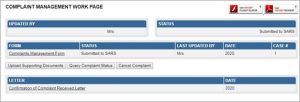
- Click the hyperlink of the letter that you would like to view.

- The letter will be displayed as indicated below.
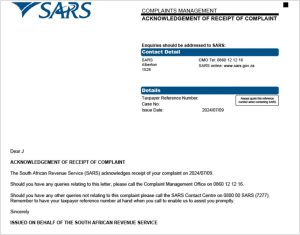
Definitions, acronyms and abbreviations
The definitions, acronyms and abbreviations can be accessed here – Glossary webpage.
Legal disclaimer: In the event of conflict or inconsistency between this webpage and the PDF version of the guide, the latter shall prevail.

